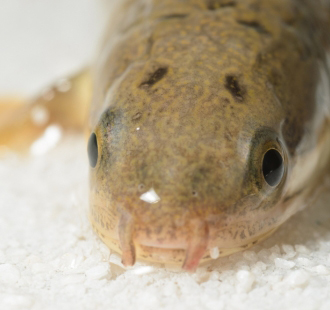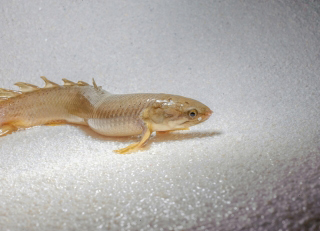Walking Fish Provides Clues to the First Tetrapods
Researchers Study Living Fish to Gain Insight Into Fossil Record
Arguably one of the most significant events in the history of life on Earth occurred when the first vertebrates walked on land. The date when types of prehistoric fish made the move to land and began the evolutionary journey that would lead to the tetrapods keeps changing in the light of new fossil discoveries.
Tetrapods
Tetrapods are vertebrates, this group includes the amphibians, reptiles, birds and mammals and that means, we are tetrapods too. One of the most important fossil discoveries in recent years, was made in a limestone quarry in Poland. On one stone slab scientists discovered strange track-like marks about fifteen centimetres wide. These were controversially interpreted as having been made by the limbs of an animal capable of moving around on land. It was envisaged that whatever strange creature made these marks, it must have been more than two metres long. This trace fossil suggests that the first animals walked on land around 400-395 million years ago, some thirty-five million years earlier than previously thought.
To read more about this Polish discovery: Clues to the First Land Animals?
Walking Fish
A team of researchers from McGill University (Montreal, Canada), have turned to a living fish in order to gain a better understanding of the evolutionary changes that must have taken place to allow certain types of fish such as the sarcopterygians to adapt to a more terrestrial lifestyle. If, sometime around 400 million years ago (Lower Devonian Epoch), a group of fish began exploring terrestrial environments, the first stage on the long evolutionary journey to the tetrapods, how did these fish do it? What changes to their bodies and fins took place to allow them to adapt to this new habitat?
Helping to answer these questions was the aim of the research team at McGill University and to do this they turned to a living (extant) fish called Polypterus.
Little Fish Takes Part in “Ground Breaking” Experiments
Picture credit: McGill University
The Polypterus Genus
There are ten or so species in the Polypterus genus, as far as we at Everything Dinosaur know, they are all African and freshwater fish. Polypterus is the only vertebrate known to science that possesses lungs and is capable of breathing air but has no trachea.
These little fish have been studied for more than one hundred and fifty years, Thomas Huxley no less was involved in some of the earliest research. He placed them in the Order Crossopterygii, now regarded as a synonym of the Sarcopterygii – although this classification has now been largely disproved. The first successful domestic breeding programme commenced in 2005, this paved the way for laboratory studies.
“Walking” on Land
The McGill team in collaboration with the University of Ottawa, studied Polypterus fish to show what might have happened when fish first attempted to walk out of the water. These air breathing fish can “walk” on land, (really it is a bit of shuffle), but they do superficially resemble Devonian sarcopterygians, (hence Huxley’s classification). The scientists raised juvenile Polypterus on land for nearly a year, with an aim of revealing how these “terrestrialised” fish looked and moved when compared to Polypterus specimens raised in a more normal environment.
Project leader, Emily Standen, a former McGill University post-doctoral student stated:
“Stressful environmental conditions can often reveal otherwise cryptic anatomical and behavioural variation, a form of developmental plasticity. We wanted to use this mechanism to see what new anatomies and behaviours we could trigger in these fish and see if they match what we know from the fossil record.”
The team discovered that these fish underwent remarkable anatomical and behavioural changes in response to their stressful environment. These fish walked more effectively by placing their fins closer to their bodies, lifted their heads higher and kept their fins from slipping as much as fish that were raised in water.
Polypterus Showed Anatomical and Behavioural Changes
Picture credit: McGill University
Fellow researcher, Trina Du (McGill University PhD student) explained:
“Anatomically, their pectoral skeleton changed to become more elongate with stronger attachments across their chest, possibly to increase support during walking and a reduced contact with the skull to potentially allow greater head or potential neck motion.”
Hans Larsson, Canada Research Chair in Macroevolution at McGill and an Associate Professor at the Redpath Museum added:
“Because many of the anatomical changes mirror the fossil record, we can hypothesise that the behavioural changes we see also reflect what may have occurred when fossil fish first walked with their fins on land.”
“Terrestrialised” Polypterus
The “terrestrialised” Polypterus is unique and provides fresh ideas on how fossil fishes may have used their fins in a terrestrial environment and what evolutionary processes may have been involved. Hans Larsson went onto to say that this experiment was the first example that they were aware of, that demonstrated developmental plasticity may have facilitated a large-scale evolutionary transition, by first accessing new anatomies and behaviours that could later be genetically fixed in the population by natural selection.
The study was conducted by Emily Standen, University of Ottawa, and Hans Larsson, Trina Du at McGill University and supported by the Canada Research Chairs Program, Natural Sciences and Engineering Research Council of Canada (NSERC) and Tomlinson Post-doctoral fellowship. It has been published in the journal “Nature”. Everything Dinosaur acknowledges the help of McGill University in the compilation of this article.



